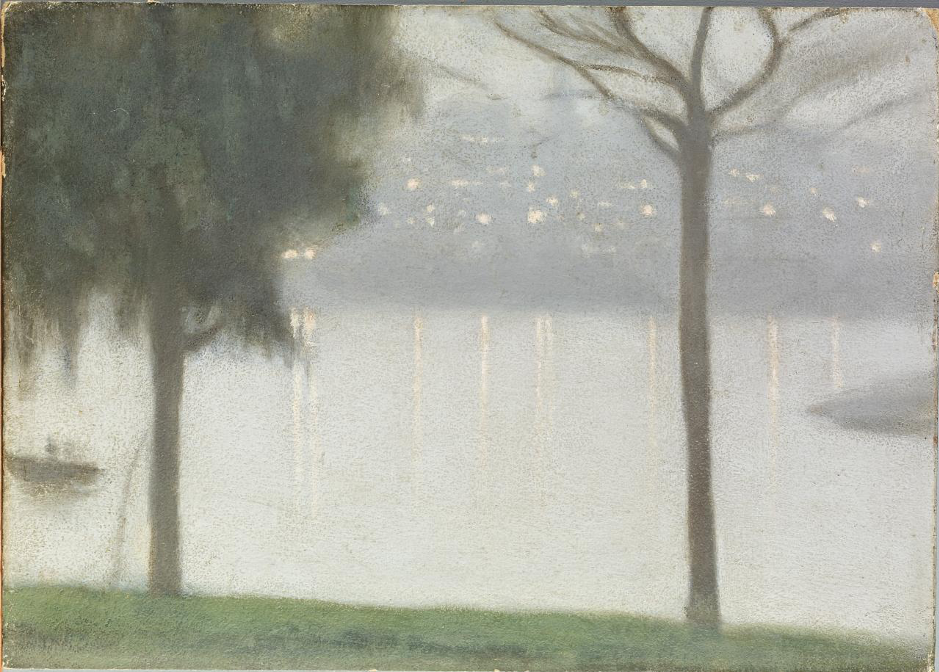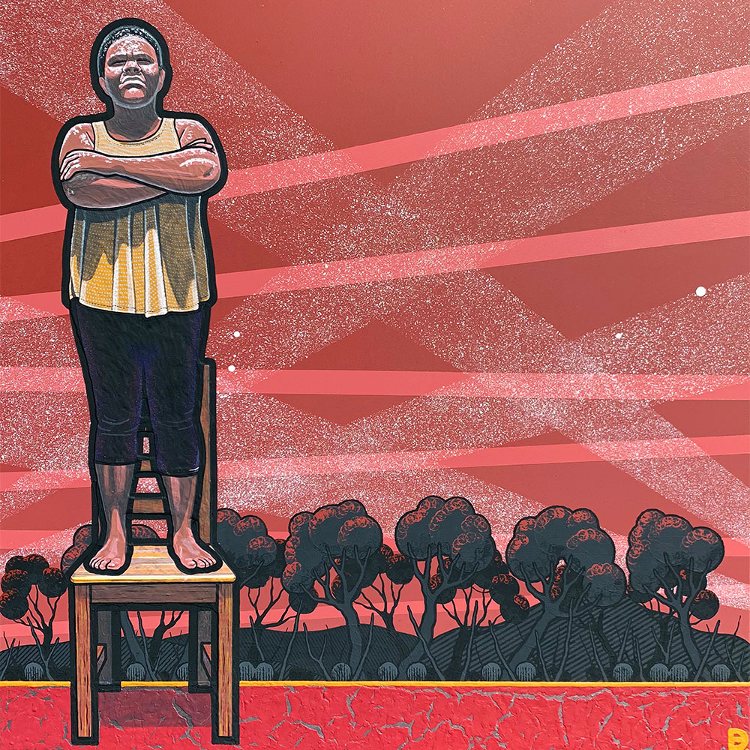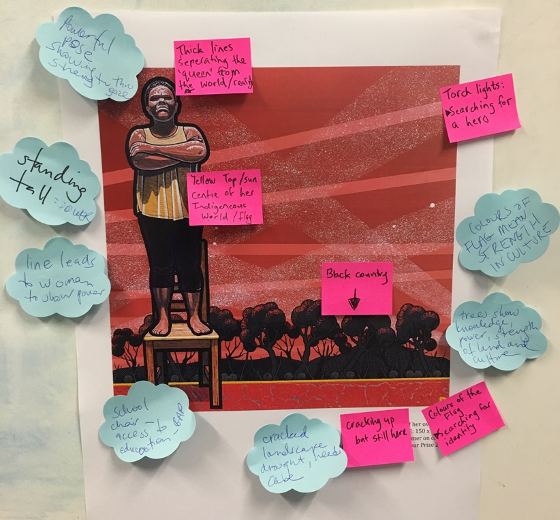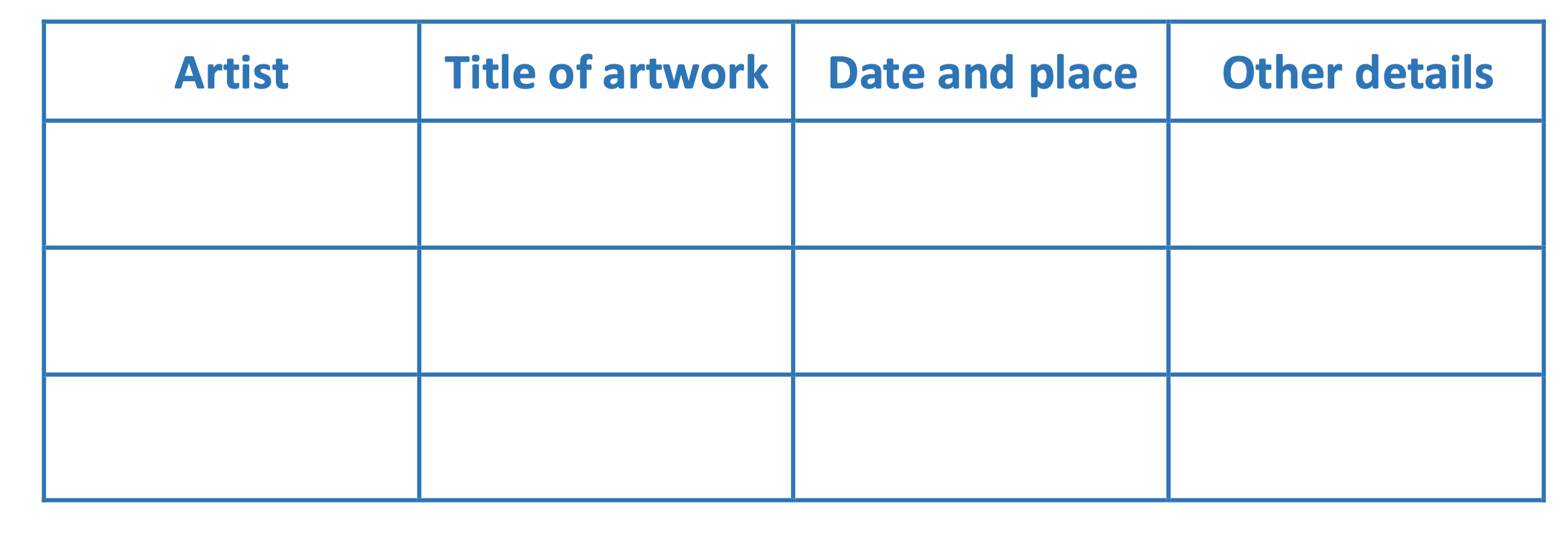Visual Arts students respond to and interpret visual images. To make meaning of visual images, students use Visual Arts language and visual literacy to:
- decode signs and symbols
- read visual conventions
- identify the use of materials, techniques, technologies and processes by the artist/s.
Joint deconstruction is a collaborative strategy that may be used to make meaning from images and artworks. Joint deconstruction builds skills for use in discussion and analysis of how different ideas and viewpoints are expressed in artworks and how they are read and viewed by audiences in multiple ways.
The following strategy may be completed as a whole class or in smaller groups or pairs, and can be implemented in the classroom, gallery, museum, or public space using a range of visual and multimedia including
- paintings
- photographs
- sculptures
- street art
- posters
- moving images.
Using art element descriptions to annotate an artwork
When first interpreting an artwork, students must be able to identify and describe the various art elements an artist has selected in the creation of an artwork. As an extension of 'Introducing art elements in context' and 'Using sentence frames to interpret art', teachers might encourage students to annotate artworks, either with post-it notes or in written form on reproduced images.
To do this
- The teacher presents an enlarged image of a work on the whiteboard or provides reproduced copies to pairs or small groups of students. For example,

Clarice Beckett
Across the Yarra (c. 1931)
oil on cardboard
32.5 × 45.9 cm
National Gallery of Victoria, Melbourne
Purchased through The Art Foundation of Victoria with the assistance of the Marjorie Webster Memorial, Governor, 1985
Photo:
National Gallery of Victoria, Melbourne
- Students are encouraged to circle, highlight, annotate, stick post-it notes on the artwork, naming and describing the identified art element.

Clarice Beckett,
Across the Yarra (c. 1931)
- The teacher leads a discussion about the students' annotations, leading them to generate interpretations or evaluations of the artwork (see 'Using literal, inferential, and evaluative questions').
Curriculum links for the above examples:
VCAVAE034,
VCAVAR038,
VCAVAE041,
VCAVAR045.
Using literal, inferential, and evaluative questions
Another way teachers can jointly deconstruct an image or artwork is by using
literal, inferential and evaluative questions. The three types of questions help to scaffold students' viewing and interpretation of the artwork.
The worked example below uses the artwork,
Queen of Her Own Stage (2019) by Blak Douglas, which won the 2019 Kilgour Prize.

Blak Douglas
Queen of Her Own Stage (2019)
synthetic polymer on canvas
150 x 150cm
Retrieved from
https://blakdouglas.com.au/portfolio/queen-of-her-own-stage/
- Teacher introduces the selected image/artwork. If in a gallery, museum or public space, students are encouraged to gather closely around the artwork.
- Teacher asks students to look closely at the selected image for some time.
- Teacher asks the students literal questions such as:
- What do you see? What do you notice? What did you notice first and why?
- What art elements can you identify? Which art elements dos the artist use over other elements? (for example, colour, line, etc).
- What is the lightest part of the artwork? The darkest? Or has the artist used similar tones?
The teacher must stress that students are responding at this point; they are only identifying or describing what they can see. Students may be given some time to articulate or note down their literal responses.
- Teacher leads a discussion about what the students see in the image.
- Students are now asked to make inferences drawing on their list of literal responses. Teacher prompts may include:
- Why do you think these colours have been used?
- What might … mean?
- Students use art terminology and descriptive language to write their inferences on post-it notes.
- The teacher may support students by asking them to consider Visual Arts elements and principles such as
- power
- ideology
- representation
- seduction
- gaze
- intertextuality
- multimodality.
- Using post-it-notes confirms students' responses and enables them to notice the similarities and differences between responses. All responses must be accepted.
- If possible, students paste the post-it-notes around the images.
- The teacher or group leader uses the post-it notes as prompts for generating student dialogue about the artwork/image.
- Post-it-notes may be re-positioned to create clusters of similar ideas or themes.
- The example below includes Post-it notes from students who have added inferences to the work after discussion. Notes include: "thick lines, separating the 'queen' from the world/reality" and "torch lights: searching for a hero or looking outward."

- The teacher invites students to read the commentary about the artwork, including
- artist
- title
- material and techniques
- date created
- place of creation
- other details supplied.
To do so, the students may use textbooks or online resources, and use a graphic organiser, such as the table below, to record their information.

- The teacher asks students to evaluate how these details impact on their meaning-making of the artwork.
For example, for
Queen of Her Own Stage, the students might evaluate the image as a comment on Aboriginal and Torres Strait Islander experiences in Australia, given the artist, Blak Douglas, is a Koori visual artist.
Curriculum links for the above example: Curriculum links for the above examples:
VCAVAE034,
VCAVAR038,
VCAVAR039,
VCAVAE041,
VCAVAR045,
VCAVAR046